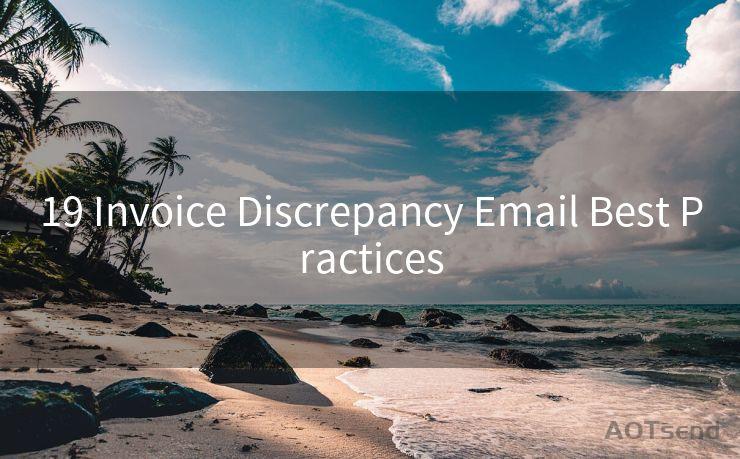19 Invoice Discrepancy Email Best Practices




When it comes to handling invoice discrepancies, clear and prompt communication is key. Email remains a primary tool for such communications, and following best practices can help resolve issues smoothly. Here are 19 best practices for writing invoice discrepancy emails that are clear, professional, and effective.

1. Subject Line Clarity
Craft a subject line that summarizes the invoice discrepancy. For example, "Invoice #12345 Discrepancy Inquiry". This helps the recipient understand the email's purpose immediately.
2. Formal Greeting
Always start with a formal greeting, addressing the recipient by their proper title and name. This sets a professional tone for the communication.
3. Introduction to the Issue
Briefly introduce the invoice discrepancy in the opening paragraph. Mention the invoice number, date, and the specific discrepancy observed.
4. Detailed Description of the Discrepancy
Provide a clear and concise description of the discrepancy. Include any relevant details such as the amount, the item or service in question, and any supporting documentation or evidence.
5. Request for Clarification or Correction
Ask for clarification or correction from the recipient. Be specific about what information you need to resolve the discrepancy.
6. Polite and Respectful Tone
Maintain a polite and respectful tone throughout the email. Avoid accusatory language or an aggressive approach, as this can hinder effective communication.
7. Use of Bullet Points or Lists
If there are multiple discrepancies or points to address, use bullet points or lists to organize your information. This enhances readability and clarity.
8. Attachment of Supporting Documents
If you have any supporting documents, such as a copy of the invoice, screenshots, or other evidence, attach them to the email for reference.
9. Call to Action
End the email with a clear call to action, stating what you expect from the recipient. Whether it's a response, correction, or further clarification, make it explicit.
10. Expression of Appreciation
Thank the recipient for their time and attention to the matter. This shows professionalism and courtesy.
11. Follow-Up Plan
Mention when you plan to follow up if no response is received within a certain timeframe. This ensures the issue doesn't get lost or forgotten.
12. Avoiding Redundancy
Keep the email concise and avoid repeating information. Redundancy can lead to confusion and frustration for the reader.
13. Proofreading and Editing
Always proofread and edit your email before sending it. Typos or grammatical errors can detract from your message's professionalism.
🔔🔔🔔
【AOTsend Email API】:AOTsend is a Managed Email Service for sending transactional emails. Support Email Types: reminders, authentication, confirmations, notifications, verification codes, invoices, password resets, account activations, billing statements, two-factor authentication (2FA), and one-time passwords (OTP) emails, etc. $0.28 per 1000 Emails. 99% Delivery, 98% Inbox Rate.
You might be interested in:
Why did we start the AOTsend project, Brand Story?
What is a Managed Email API, How it Works?
Best 25+ Email Marketing Platforms (Authority,Keywords&Traffic Comparison)
Best 24+ Email Marketing Service (Price, Pros&Cons Comparison)
Email APIs vs SMTP: How they Works, Any Difference?
14. Use of Templates (If Applicable)
If you regularly handle invoice discrepancies, consider creating an email template. This can save time and ensure consistency in your communications.
15. Consideration of Time Zones
When sending emails, be mindful of the recipient's time zone. Timing can affect the response rate and the overall effectiveness of your communication.
16. CC or BCC (If Necessary)
If other team members or departments need to be aware of the discrepancy, consider using the "CC" or "BCC" function appropriately.
17. Confidentiality and Privacy
Ensure that any sensitive or confidential information is handled appropriately. Avoid sharing such details with unnecessary recipients.
18. Closing Statement
End the email with a professional closing statement, such as "Thank you for your attention to this matter." or "I look forward to your prompt response."
19. Signature Block
Include a professional signature block with your name, position, contact information, and any relevant links (e.g., company website).
By following these best practices, you can ensure that your invoice discrepancy emails are clear, professional, and effective, leading to smoother resolution of issues and maintaining positive business relationships.




Scan the QR code to access on your mobile device.
Copyright notice: This article is published by AotSend. Reproduction requires attribution.
Article Link:https://www.mailwot.com/p4771.html



